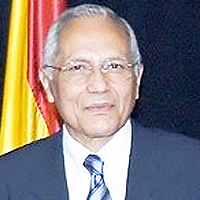A case report of Multi System Atrophy (MSA) with cross over features of Progressive Supranuclear Palsy (PSP)
Published on: 13th September, 2021
OCLC Number/Unique Identifier: 9252228462
We describe an interesting case of Multi System Atrophy who had cross over features of progressive supranuclear palsy along with classical clinical findings which led to the diagnosis.
A rare presentation of orbital dermoid: A case study
Published on: 10th August, 2021
OCLC Number/Unique Identifier: 9168714793
Introduction: A dermoid cyst is a developmental choristoma lined with epithelium and filled with keratinized material arising from ectodermal rests pinched off at suture lines. These are the most common orbital tumors in childhood. They are categorized into superficial and deep. Superficial orbital dermoid tumors usually occur in the area of the lateral brow adjacent to the frontozygomatic suture. Infrequently a tumor may be encountered in the medial canthal area [1], which is the second most common site of orbital dermoids. We report a case where a swelling presented in the medial canthal area without involving the lacrimal system.
Case report: A 43 year old lady presented with complaint of swelling near the (RE; Right eye) since 2 years duration. She presented with a solitary 1.5 cm x 1 cm ovoid, non-tender, non-pulsatile, firm, non-compressible mobile swelling with smooth surface over the medial canthus of right eye. (MRI; Magnetic Resonance Imaging) brain and orbit showed right periorbital extraconal lesion and the (FNAC; Fine Needle Aspiration Cytology) suggested of Dermoid Cyst. RE canthal dermoid cyst excision was done under Local Anasthesia.
Conclusion: Complete surgical excision in to be treatment of choice for dermoids. Since medial canthal mass can involve the lacrimal system, it becomes necessary to perform preoperative assessments using (CT; Computed Tomography), MRI or dacryocystography while planning the surgical approach. Silicone intubation at the beginning of the surgery is an easy and effective way of identifying canaliculi and of preventing canalicular laceration during dermoid excision if the lacrimal system is found to be involved.
A comparative study of post-operative astigmatism in superior versus superotemporal scleral incisions in manual small incision cataract surgery in a tertiary care hospital
Published on: 5th August, 2021
OCLC Number/Unique Identifier: 9168726769
Background: In developing countries, manual small incision cataract surgery is a better alternative and less expensive in comparison to phacoemulsification and thus the incision is an important factor causing high rates of postoperative astigmatism resulting into poor visual outcome. Thus, modifications to the site of the incision is needed to reduce the pre-existing astigmatism and also to prevent postoperative astigmatism. Modification to superotemporal incision relieves pre-existing astigmatism majorly due to its characteristic of neutralizing against-the-rule astigmatism, which is more prevalent among elderly population and thus improves the visual outcome.Aims: To study the incidence, amount and type of surgically induced astigmatism in superior and superotemporal scleral incision in manual SICS.Methodology: It is a randomized, comparative clinical study done on 100 patients attending the OPD of Ophthalmology at a tertiary care hospital, with senile cataract within a period of one year and underwent manual SICS. 50 of them chosen randomly for superior incision and rest 50 with superotemporal incision. MSICS with PCIOL implantation were performed through unsutured 6.5 mm scleral incision in all. Patients were examined post-operatively on 1st day, 7th day, 2nd week and 4th week and astigmatism was evaluated and compared in both groups.Results: It is seen that on postoperative follow up on 4th week, 77.78% of the patients with ATR astigmatism who underwent superior incision had increased astigmatism whereas, only 13.63% of the patients with ATR astigmatism who underwent supero-temporal incision, had increased astigmatism but 81.82% had decreased ATR astigmatism. However, 77.78% of the patients with preoperative WTR astigmatism who underwent supero-temporal incision, had increased astigmatism, whereas 44.45% of the patients with WTR astigmatism preoperatively, had increased astigmatism in contrast to 50% had decreased amount of astigmatism. It is also seen that the supero-temporal incision group had more number of patients (78%) with visual acuity better than 6/9 at 4th postoperative week than superior incision group (42%).Conclusion: This study concludes that superior incision cause more ATR astigmatism postoperatively whereas superotemporal incision causes lower magnitude of WTR astigmatism, which is advantageous for the elderly. Besides superotemporal incision provides better and early visual acuity postoperatively.
Victim of violent death: what is the role of alcoholemia?
Published on: 25th August, 2021
OCLC Number/Unique Identifier: 9206121369
Introduction: The tendency to impulsive behaviors and/or violence is exacerbated after alcohol consumption. Still, the relation between alcohol/violent deaths reported in the literature is not accurate, and in general, alcohol is only seen as a trigger to aggressive actions. The relationship of the victims with their blood alcohol is less studied. They were especially concerned about the role of alcohol as a risk factor for victims of unnatural death. Thus, our goal is to check the influence of alcohol in victims of violent deaths as homicides, suicides, and accidents.
Materials and methods: Retrospectively the medical records of 805 autopsies performed at the Institute of Forensic Medicine (IML) of Franco da Rocha, in the period 2001 to 2017 were reviewed. The variables studied were sex, age, types of violent death rates, and alcohol - these were considered positive when above 0.3 mg/ml.
The dosage of blood alcohol concentration (BAC) was performed using samples of 10 ml of blood collected at necropsy, is preferably taken from the cardiac chambers or of the right femoral vein. Dosages of alcohol in blood samples were done in the Forensic Toxicology Center of the IML by gas chromatography, using the technique of separation “headspace” and double column.
Results: Drug testing for alcohol was available for 488 (79.1%) of 617 necropsies. Of the 617 subjects studied, 532 (85.7%) were male, and 85 (13.8%) were females (with high rates of adolescents). The vast majority (n = 230) were killed, and 40.5% of victims had BAC above 0.3 mg/ml of blood. Traffic accidents came next, accounting for 181 deaths, with 41% of victims presenting positive BAC.
Discussion: High blood alcohol levels of the victims were associated mainly with the genesis of accidents (drowning, falls, traffic, aspiration/ smothering) and murder (with impaired ability to resist or by causing the release of impulses to engage in violent situations), about 40% of cases.
Conclusion: Our results indicate that alcohol abuse is a risk factor for victims of violent death. In these cases, alcohol has two types of action. Direct: contributes to accidents of various kinds - from traffic by decreasing powers of concentration, attention, and loss of reflexes, to other types of accidents such as drowning, falls, swallowing disorders causing airway obstruction, and mechanical asphyxia. And they were indirect, making it easier for individuals to engage in conflict (and thus become victims of crimes).
Application and utility of alternative methods in isolation of pure cells from forensic biological mixtures in modern-day: a review
Published on: 23rd August, 2021
OCLC Number/Unique Identifier: 9206128467
Development of genetic profiles from the biological mixtures has remained challenging, although modern-day technologies may help forensic scientists to attain a reliable genetic profile in the identification of the accused.
In the case of rape, vaginal swab exhibits usually contain epithelial cells of victims and sperm cells of accused, such samples are more challenging when there is more than one contributor. In such cases, separation of distinct cells from a mixture that includes blood cells, epithelial cells and sperm cells for their single genetic profile is important.
In the last ten decades several new techniques were developed and invented for the separation of single cell from the biological mixture that includes differential lysis, laser micro-dissection, cell sorting (FACS), sieve-based filtration, (vi) micro-fluidic devices or immunomagnetic beads cell separation of fresh samples, and the magnetic activated cell sorting (MACS).
Out of them, some techniques have been commonly applied for cell separation in forensic biology. Each technique has its own limitation. Some recent studies showed, magnetic activated cell sorting (MACS), laser capture microdissection (LCM), DEPArray technology and fluorescence activated cell sorting (FACS) has proved to be effective in separation of single cell from cell mixtures.
Therefore, in this review we have evaluated these four alternative methods and their potential application in the modern-day over the others for the separation of a single cell from the mixture. In this review we also discuss the advantage of these methods and their modern–day applicability and acceptance in the forensic world.
Difference between conventional and modern methods for examination of fingerprints
Published on: 10th August, 2021
OCLC Number/Unique Identifier: 9206115286
The impression of frictional ridges of the finger is known as fingerprints. Owing to this uniqueness, the fingerprints have long been used to identify a person since Ancient times. In any crime scene the presence of fingerprint makes the identification of the Culprit very easy. The fingerprints can also easily be embedded on any item such as paper, Clothing and body of the victim. To utilize this uniqueness of fingerprints forensic experts devised many techniques to obtain a clear fingerprint. These come under two categories i.e. Conventional and modern methods.
The conventional methods are although important but there are limitations of them. Just take the example of powder method. Powder method require different powders for different Surfaces and colors, but modern method like quantum dots method can easily detect Fingerprints on all surfaces regardless of their color giving great resolution in seconds. Other methods like physical developer method is very time consuming and expensive, carbon Black method creates mess and does not work on porous surface, iodine fuming and Naphthaloflavin does have an advantage that it can bring up prints on skin also but it does not Work on metallic surfaces. VMD also fails on heavy plastic polymers and body oils. But some modern methods like nanotechnology can obtain high resolution prints old and dried prints also within 3 minutes. Laser technology is very fast, accurate and can be used for Fingerprints up toten years old also on any surface without any mess. Multimetal deposition Method can even be used to identify smokers and drug addicts and can be used Porous, non-porous and wet surfaces.
Effects of food programme for enhancing obesity children healthy of their abilities and expectations to self-efficacy for preventing early childhood
Published on: 13th September, 2021
OCLC Number/Unique Identifier: 9252205670
This study aims to assess parents’ perceptions of their responses to the perceived awareness programme competency abilities and expectations for enhancing parents on weight control of their pre-school children in preventing with Obesity. It has defined self-efficacy as one’s belief in one’s ability to succeed in specific situations and accomplish a task with the theoretical framework of Bandura’s Model by quasi-experimental research in 16 weeks. To promote the self-efficacy and expectations, the 10-item Questionnaire on Self-Efficacy Program, the 22-item Questionnaire on Parents’ Efficacy Interaction, and the 46-item Questionnaire on Parental Expectations assessed parents’ perceptions. A sample size consisted of 14-pre-school children whose age ranged 2-5 years old at the Child Development Demonstration Centre, Khon Kaen University was selected. Providing knowledge, teaching, demonstration, experimentation, and organized activities were organized. Parents’ perceptions of their abilities for controlling children’s weight and height with pre- and post-experimental programmes differentiated, significantly. Parents’ responses to the post performances are over than pre-experiment for the QSEP, the QPEA, and the QPE, differently. They answered and followed up on child management with parents online for 16 weeks, continuously. The obese early childhood at the CDC Demonstration Centre, Faculty of Nursing used the food programme to self-efficacy with their parents taking part and cooperating well in specifying research objectives. There are 2,958,441 children in rural areas are lacking attention, because of food and health problems in the 19,171-Child Development Centres none yet have food programmes to prevent health and hygiene problems. Although Thailand took the next leap forward for its investment in Early Childhood Development through legislation, improved quality services, and social transfer grants for families with young children since 2018.
Identity-related attitude in the child development centres for protecting educational asylum of early childhoods: From rural communities to schooling cities
Published on: 13th September, 2021
OCLC Number/Unique Identifier: 9252227524
The global identities of parents’ popularity in rural communities to make-decision effects of their attitudes to transfer their Early Childhood from Child Development Centres and Local Primary School for moving study into the schooling cities that looks like children’ asylum of their educational conditions, problems, administration’ school directors, teachers, and schools’ environments to protect that described. The involving CDCs’ perceptions got using the 25-item My CDC Identity Inventory (MCDCII) in five scales, three options. Teacher and Caregiver-Early Childhood interactions have assessed with the 30-item Questionnaires on Teacher Identity Interaction (QTII) in five scales on five options. The 10-item Local Identity-Related Attitude (LIRA) has been associated with a sample of 300 children’s parents, teachers, and caregivers. The determination of efficient predictive value (R2) shows that 30% of accepted the identities on cohesiveness, competitiveness, physical indoor and outdoor environmental development, satisfaction, and strong-sense identity. 74% of their CDCs can protect the educational asylum of early childhoods from rural communities. The R2 value shows 49% of the variance in children’s parents’ perceptions was because of the MCDCII have associated. Despite Thailand’s success in expanding educational access, new empirical evidence suggests that much more needs to be done to maximize the potential of its students. The performance gaps among schools have disadvantaged and poorer-performing students have concentrated in small rural village schools. The Thai pre-primary school system is dramatically lacking in qualified the CDCs’ learning environments and achievements, and teachers. It allocated small rural schools teachers with lower qualifications and teaching experience.
Associated indicator factors among inappropriate malfunctions’ development for the 9-month-old-baby
Published on: 10th September, 2021
OCLC Number/Unique Identifier: 9252205593
To investigate the associated an inappropriate development of the 9-month-old-baby with the Matched Case-Control Study on five categories and three factors including predisposing, contributing, and complementary through the babies’ malfunction development with the Analysis Research Method was analyzed. The babies’ developing crisis was enhanced as the guidelines for promoting healthy babies’ development via the DSPM in the future of Thailand. Creative the Interview Factor Questionnaire analyzed the 130-child caregivers’ parenting matching 65-pairs-case-control group into 5 parts: the Predisposing Factor Questionnaire, the Positive Interview Form; the Baby-Self-Efficacy Form; the Inappropriate Contributing Interview Form; the Inappropriate Development Interview Form for assessing the motor skills, self-efficacy, predisposing, contributing, and complementary factors of the 9-month-old-baby, respectively. Highest, Middle, and Lowest means levels are indicated. The child caregivers’ are presenting responses, overall on the Predisposing Factor Questionnaire on five categories’ motor skills, and the Inappropriate Development Interview Form showed off at the Middle Levels. The Positive Interview Form, the Baby-Self-Efficacy Form, and the Inappropriate Contributing Interview Form comprised at the Highest Levels for the predisposing, self-efficacy, and contributing factors for developing the 9-month-old-baby, respectively. To help professionals assess the factors affecting a child’s development into environmental factors, biological factors, interpersonal relationships, and early environments and experiences that identified in contributing to growth, brain, emotional, social developments at early childhood are the GM, FM, RL, EL, and PS motor skills practices with the DSPM for Thai’s children are also more likely to have health problems all child ages with the knowledge and skills.
Developmentally appropriate practices on knowledge skills for contributing child’s intelligences of receptive language skills in appropriate and inappropriate early childhoods
Published on: 10th September, 2021
OCLC Number/Unique Identifier: 9252226608
To investigate the variables correlation analysis research method for assessing the caregivers’ perceptions in two groups including dependent and independent variables to correlate the measuring of early childhoods. Typically, in correlated data, for jointly normally distributed data with relevant outliers that can use a correlation as a measure of a monotonic association. Designing the 65-paired samples for the Thai Model of early detection and intervention of children as the health care system guidelines from 26-CUPs have compared. Using the DSPM divided into 65-appropriate and 65-inappropriate development early childhoods for every 13 CUPS that depends on talented children. Selecting the Receptive Language (RL) skills identified in contributing growth relative factors with four research instruments: the EPRLS, PRLF, CNRLF, and CMRLF are valid and reliable significantly. Comparisons of the appropriate and inappropriate early childhoods are differences ( < .05), the intercorrelation circumflex nature analysis (p < .05), positively. The R2 values show that 26% and 55% of the variance in training caregivers’ factor skills on the PRLF, CNRLF, and CMRLF to the EPRLS in inappropriate and appropriate early childhoods, respectively. Developmentally Appropriate Practice is a perspective in a child’s development: social, emotional, physical, and cognitive-based on the child’s cultural background: community, family history, and family structure.




